Winter can be a tough time for gardeners in cold climates. As the ground freezes, we start to get antsy for the days when we can stick our hands in some soil. Potting rooms are great for staying occupied until spring. There’s no rule that says potting has to happen in a shed — you can bring your hobby right into the house. Whether you’re lucky enough to be adding a potting room on to your home or simply want to co-opt a corner of the mudroom or back entry area, here are some tips for making the most of it.
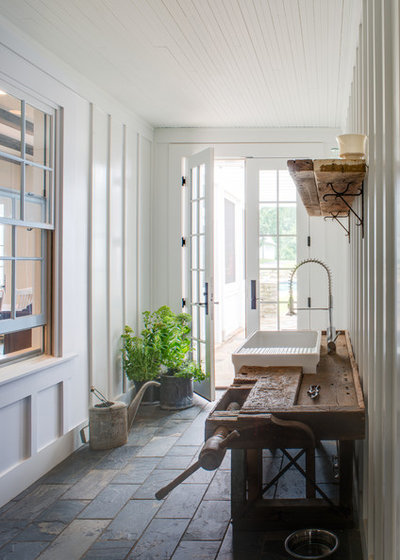
Donald Lococo Architects
“The trick to the potting room is to make it feel both inside and outside simultaneously,” says architect Donald Lococo. “Don’t hesitate to fill the space with elements like mulch, peat and plants, which can be nicely balanced with picture frames, drapery and even books.”
This farmhouse’s potting room serves as a lovely buffer between a kitchen and a garage. Lococo used board and batten siding and a rustic clefted slate floor to make it feel like it was a breezeway closed in at a much later date.
The mix of slate flooring with more refined interior elements (the shiny faucet and sink) led Lococo on a journey to find the right potting bench. When he came across a rustic antique tanner’s bench complete with interesting wooden vises, he knew he had found a piece full of history. Its dings and scratches all told the story of past uses, and his modern-day gardening clients could add to these layers of its working history. Plus, it had ample room for incorporating a sink.
Choose a tough, durable floor that can hide dirt. As you look at flooring options, imagine yourself sweeping potting soil out the door with a broom. This room has a naturally clefted slate floor. To save money, Lococo purchased 16-inch by 16-inch tiles and had them cut in half. He then had them laid in a staggered pattern that was fitting for a farmhouse.
If you have a sink, incorporate a spray nozzle. It’s much easier than having to center the pot underneath the faucet. You can even stretch it out across the countertop to pots that aren’t in the sink.
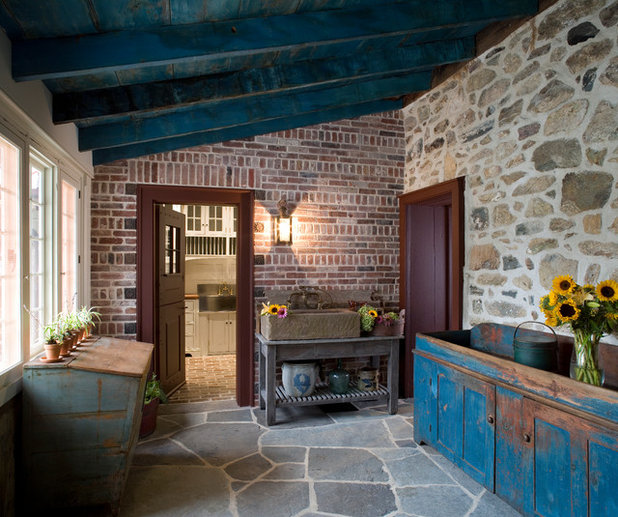
Peter Zimmerman Architects
This fantastic potting room actually had been a covered porch that the designers enclosed and winterized.
“A working potting room should have a brick or stone floor with a central drain — a cost-effective option is a stained concrete floor,” says Eliza Montgomery of Peter Zimmerman Architects.
Salvage when you can. “Potting sheds should be built with materials that aren’t so precious that you mind if they get dirty,” Montgomery says. Opt for salvaged pieces; they are charming, and beating them up only makes them look better. Old workbenches and dry sinks are a great option. Antique pieces give a room an aged look while providing work surfaces and storage space.
Know that a sink is not a must. This room happens to have an enviable custom stone sink, but you can save a lot on your potting area project by cutting it out of the budget. You can easily make do with a watering can and give your arm muscles a workout at the same time.
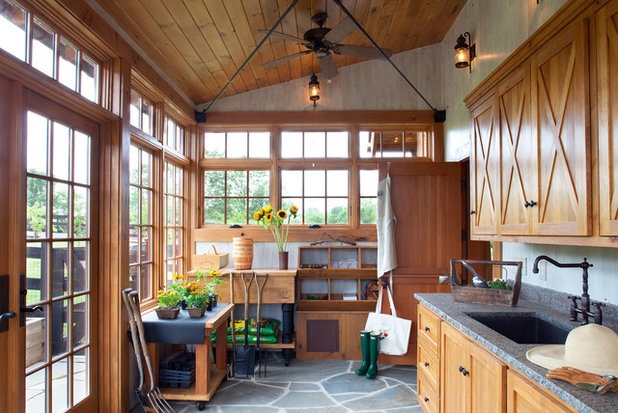
Rill Architects
Create a connection with the garden. With all of the expansive doors and windows surrounding this dream potting room, it’s the next best thing to being outside. Even if you’re working on a potting corner instead of a whole room, add a window so that you can view the garden and dream about next spring and summer. Your seedlings and plants (and you) will love the natural light.
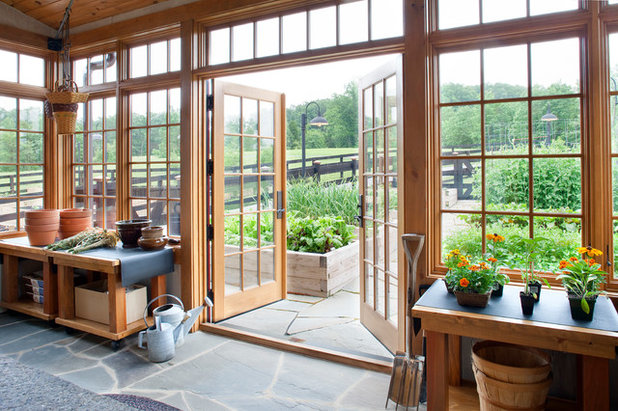
Rill Architects
The flagstones create continuity between indoors and out underfoot here. When the doors are open, only a threshold marks the line between the two.
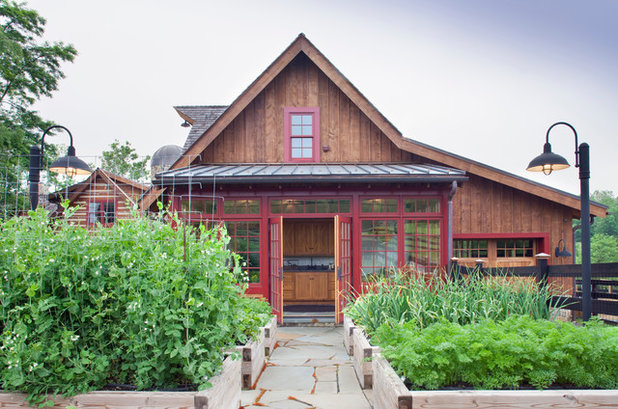
Rill Architects
Here’s the exterior of the same potting room, as seen from across the garden. The porch-like structure is a wonderful addition to the architecture.
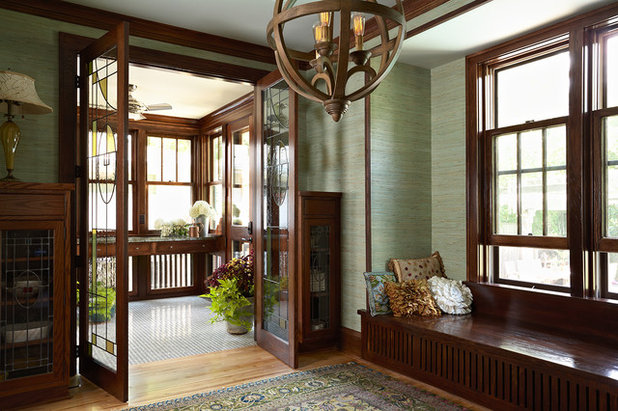
Meriwether Inc
Create a connection with your house. Architect Meriwether Felt matched dark stained walnut in the potting room (left) to match other prominent wood trim in this Minnesota bungalow. The home’s entry enjoys views through glass doors into the potting room addition.
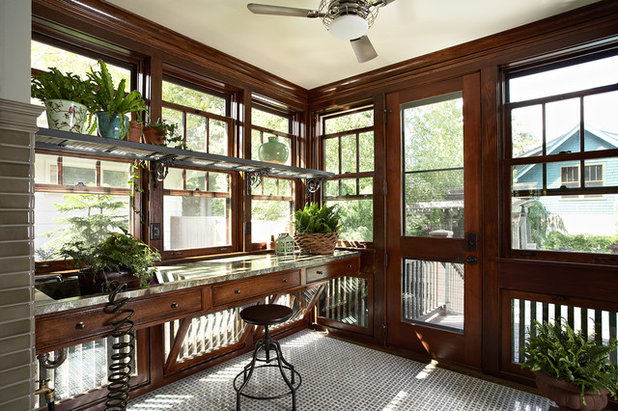
Meriwether Inc
Make room for winter plant storage. In the same potting room, there is enough empty floor space to keep the homeowner’s large potted plants warm in the winter. Shelves provide space for overwintering plants like begonias and geraniums. You also may want some space for stashing seed catalogs, reading gardening books and sketching your ideas.
Learn more about this dream potting room addition
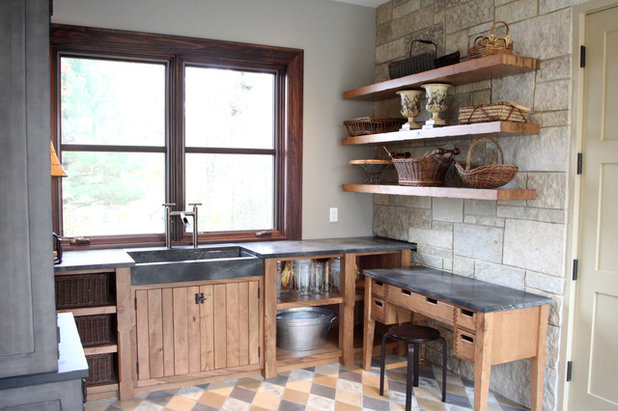
KL Cabinetry Design
Choose a hardworking countertop. Soapstone (seen here on the countertops and sink) is a popular option for potting rooms. It will show scratches and chips, though, so you’ll need to know whether you think those will add to its charm or if they will drive you crazy. (This ideabook will help you figure out how you’ll feel about chipping.)
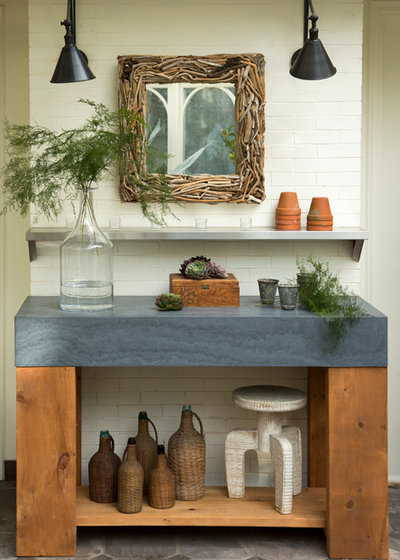
Lisa Tharp Design
Fireslate, commonly used in school chemistry labs, is another great choice. Interior designer Lisa K. Tharp chose the surface for its durability here.
Give yourself enough light. On gray days and dark evenings, you’ll want your potting room to feel cheery — and you’ll want to see what you’re doing.
This potting bench is perfectly styled for a photo shoot, but its usual state involves a lot more dirt and plants. It’s a favorite spot for the homeowner to get his green thumbs dirty.
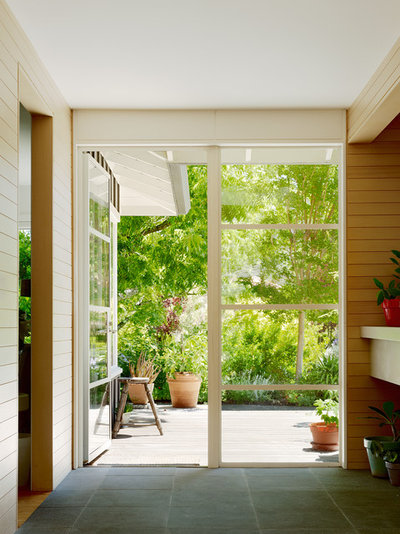
Kuth / Ranieri Architects
Know that a modest potting alcove will give you ample space. Of course, most of us don’t have a whole room to give over to the plants or the budget to enclose a porch or build a potting room addition.
But chances are, you can find a spot in which to carve out a potting alcove. Perhaps you can take over part of a mudroom or laundry room.
“Make sure the space is directly accessible to both an exterior and interior space, such as a corner of a garage or vestibule-like transitional space,” architect Lococo advises. Placing the potting area adjacent to a side or back entry door will keep you from dragging dirt through the house. Just off the lovely patio here, a recessed area on the right (see next photo) has a long trough sink. The slate floor provides a good spot for storing the potted plants.
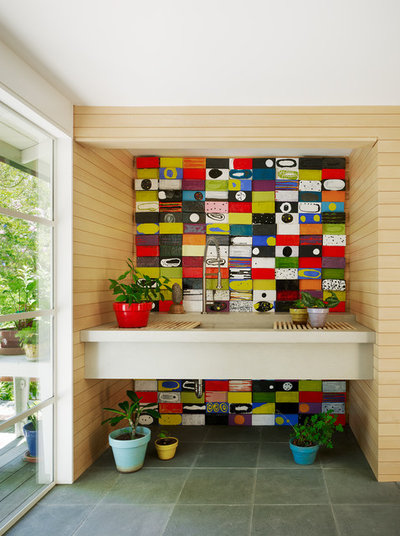
Kuth / Ranieri Architects
This beautiful potting alcove is about the same size as a washer-dryer alcove or a double closet.
The potting alcove’s design is integrated with the rest of this home’s decor. The back wall is covered floor to ceiling in handmade bricks by artist Bean Finneran.
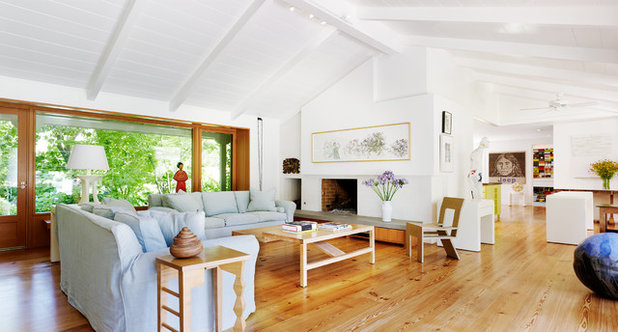
Kuth / Ranieri Architects
The colorful mosaic of bricks draws the eye to the wall, even from across the house.
Do you have a potting room or area inside your home? If so, please share a photo of it in the Comments.
More:10 Favorite Shed Features for Comfort and Joy
Browse potting benches in the Shop Houzz section





